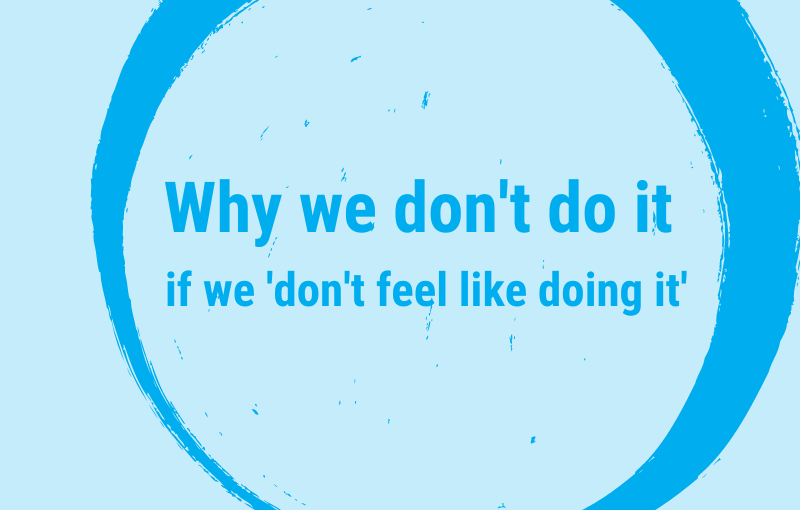How to take action and make changes in our life
Many of us share this experience:
We have an idea or a goal we want to realise, we plan to change a certain behaviour, we want to create a new habit – and we really want to get active and do this thing.
But then we don’t do it.
We don’t get started at all, or we get started but then stop again as soon as the first obstacle shows up.
So, why aren’t we taking action, why do we procrastinate and postpone, why do we quit, again and again?
It’s because of the clutter in our mind.
It’s because of all the thoughts and feelings that we got used to thinking and feeling, that we keep thinking and feeling although they don’t serve us.
Everything we do or don’t do, every action or inaction in our life, is driven by a feeling. A feeling which is caused by a thought.
If we don’t get active, it’s because we don’t ‘feel like doing it’.
As our feelings drive our actions, we only get active if we have the appropriate action-fueling feelings.
And we can only feel the ‘right’ way if we have the ‘right’ thoughts – thoughts that are creating the feelings we need to feel to take action and to create the results we want to have in our life.
Now it’s clear why we so often struggle to take action and make changes in our life:
If we try to take action without changing our thoughts and feelings, we run into problems:
We are trying to work against our mind – against the thoughts and feelings we got so used to – and that is really hard.
Let’s have a look at an example, let’s pretend I want to lose weight.
EXAMPLE – Weight Loss Goal – PART 1
My current thought is: ‘It’s really hard. I’ve tried so many times to lose weight and it didn’t work out. This time I have to make it work somehow.’
Based on that thought my feeling might be: Doubtful. Or skeptical. Maybe shameful. Or even desperate.
This type of feelings will most probably create action(s) like these: Postponing and waiting for the ‘right’ time to start the new diet. Or starting a new diet plan but giving in at the end of the next stressful day – getting to the fridge to find relief.
The result I’m creating: Another attempt to lose weight that doesn’t work out.
We can easily see here why it’s so hard to get new results if we stick to our old thoughts and feelings.
Before we can change our thoughts we need to understand what’s going on in our mind: We need to learn how to watch ourselves think.
As soon as we manage to look ‘from the outside’ into our mind and to observe our current thoughts and feelings – like we did in the example above -, we begin to understand why we struggle to make changes.
We can then decide to take control of our mind and to change our thoughts.
EXAMPLE – Weight Loss Goal – PART 2
My new – deliberately chosen and practiced – thought is: ‘It doesn’t matter what happened in the past. This time I take a different approach. I’ll make this work out for me. And I will be so proud of myself in the end!’
My feeling now is something like: Determined. Or confident. Or committed.
My action(s) will look like these: Creating a detailed plan for the dieting process, including strategies how to overcome temptations and obstacles. Deliberately and regularly imagining the feelings of pride and accomplishment. Keeping to the diet plan.
My new result is different, of course! The different approach (different thoughts and feelings) helps me to do what I want to do. I am making myself proud of myself.
As soon as we consciously change our thoughts we also change our feelings which enables us to change our actions/behaviours and therefore the results in our life.
EXERCISE
Think about the things you would like to do, the goals you wish to achieve.
Step 1 – Pick one goal. Describe the result you want to create:
……………………………………………………………………………..
(Example: ‘My paperwork is clutterfree and well organised.’)
Step 2 – What would you have to do, which actions would you have to take to create the desired result? Write it down:
……………………………………………………………………………..
(Example: ‘I go through the 3 boxes of papers (stored in the garage), the 10 binders in my filing cabinet, and the paper pile on my desk. I take up/out each piece of paper and decide: to shred or to keep/file? I reorganise the binders and file what I decided to keep. I shred what I no longer need.’)
Step 3 – Now think about what feeling you need to feel to take the necessary action and get that thing done. Do you need to feel confident? Determined? Committed? Or something else? Write it down:
……………………………………………………………………………..
(Example: ‘I feel determined.’)
Step 4 – What thought would you need to be thinking to create the feeling you listed above?
……………………………………………………………………………..
(‘Yes, I’ve become a bit lazy with my paperwork and now it’s quite messy. I don’t like that and I’m the right person to change it. I’m going to get it sorted out next Saturday.’)
Step 5 – Now practice thinking that thought. Day by day.
(Example: ‘I don’t like that and I’m the right person to change it. – I don’t like that and I’m the right person to change it. – I don’t like that and I’m the right person to change it. …’)
Expect your feelings and actions to change soon. Slowly but surely.
Get excited about the new results you will experience soon. Enjoy the change.
HOW CAN I HELP YOU?
Are you tired?
Tired of trying to (re)organise the various areas of your life entirely on your own?
Fortunately, you don’t have to figure it out all by yourself.
We can do it together.
You can decide to get my support, advice, and guidance – and achieve the desired changes in your life so much faster and easier.

